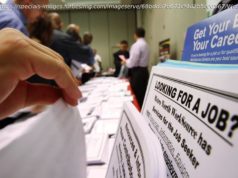Trump’s infrastructure plan won’t pay for the public projects that we need the most.
President Trump introduced his infrastructure plan Monday with a ringing preamble: « It is time, » he said, « to give Americans the working, modern infrastructure they deserve. »
That raises the question: « What did we do to deserve this? »
The plan, which the White House bills as a $1.5-trillion program, only provides $100 billion in federal funds over 10 years for major federal-state projects — and those funds are mostly, at this moment, mythical. The plan bristles with incentives to allow private investors to profiteer, to expand tolls and other user fees on crucial roads and bridges, and to despoil public lands with pipelines. It aims to fast-track the most environmentally hazardous projects, the better to keep experts and local communities from weighing in.
And it increases obligations on state and local governments just at the moment when their ability to raise funds has been hamstrung by Congress.
It is time to give Americans the working, modern infrastructure they deserve.
You’ll be hearing lots of huzzahs for this program from construction lobbyists representing builders and labor unions. Each will be pointing with anticipation to big-ticket projects in their local areas, without noticing that the program impoverishes the ability to get such projects done by any level of government.
The smart money on Capitol Hill says that the whole package is dead on arrival in Congress anyway. Progressives say it’s not big enough, and what’s there gives away too much to special interests; conservatives grouse that it’s too big and not enough of a giveaway.
None of this is unexpected, and little enough of it is new. Trump aides have been telegraphing the outlines of the infrastructure program for more than a month. The formal 55-page document issued Monday puts a bit more meat on the bones that have been rattling around since early January, but the whole package should mostly be seen as a guide to the Trump administration’s approach to governing: programs with virtually no rationale and without adequate financing, along with a commitment to getting government off the backs of the people so Big Business can saddle up.
A couple of cases in point: Trump proposes to sell off Dulles and Reagan National airports and two Washington-area highways. Why? They would be « more appropriately owned by State, local or private entities. » How so? The document doesn’t say.
He’s proposing to sell the Tennessee Valley Authority’s transmission assets. Why? « The vast majority of the Nation’s electricity needs are met through for-profit investor-owned utilities. » So? « Federal ownership of these assets can result in sub-optimal investment decisions and create risk for taxpayers. » Hmmm. Trump ought to come out to California, where we’ll fill him in on Southern California Edison and Pacific Gas & Electric.
We can start by guiding him through Edison’s San Onofre nuclear plant, permanently mothballed because of, well, a « sub-optimal investment decision » and thoroughly incompetent management. Than he can zip up to San Bruno, to a neighborhood that was leveled by a gas explosion in a PG&E main that hadn’t been properly maintained by its for-profit owner. On his way out, he can visit the final resting places of the eight people who were killed in the blast.
It’s no secret that the United States desperately needs an infrastructure upgrade. Some estimates place the cost of rectifying decades of deferred maintenance on what has already been built at $4.6 trillion through 2025. The $1.5 trillion to be handed over to corporate shareholders and other wealthy people via the tax cut would have been a healthy down payment on this bill.
« Almost every city and state has its horror stories, » Laura Tyson of UC Berkeley and Lenny Mendonca of New America observed in September: « Dysfunctional subways in New York City, lead-contaminated drinking water in Flint, Michigan, the near-collapse of a major dam in Oroville, California. »
Public spending on infrastructure has been on a steep slide since the recession, when the federal government stepped in to help financially strapped state and local governments. Public spending peaked at 2.2% of inflation-adjusted GDP in 2009; by late last year it was down to about 1.6%.
During his election campaign, Trump talked incessantly of a historic commitment to reversing this trend. It now seems that he was just yammering pointlessly.
The crux of Trump’s plan is to turn the traditional 80-20 federal-state split of financing of major infrastructure inside out, to 20-80. Where states and localities are expected to find their exponentially larger share is unclear, especially since the recent GOP tax cut bill, which Trump signed, creates new political obstacles and higher absolute dollar costs of raising the money through taxation.
The infrastructure plan encourages states and municipalities to be more welcoming to charging tolls on interstate highways, imposing passenger surcharges at small airports and « commercializing » interstate rest areas. This looks like an open invitation to private firms charging what the market will bear to anyone needing to pull off the road. The plan says restrooms should be exempt from fees (perhaps on the principle that when nature calls, it shouldn’t call collect).
The plan would give the Interior secretary, currently the ace environmental spoliator Ryan Zinke, more authority to approve pipeline construction and energy production (presumably oil and gas) in the national parks. It would eliminate the requirement that every such project receive specific congressional approval, the better to « reduce the delays and uncertainties caused » by the requirement. This elevates « streamlining » to a Platonic ideal, with immeasurable consequences for the environment. Bad consequences, obviously.
Finally, there’s a very Trump-esque $20-billion fund for « projects of national significance. » Supposedly these are « projects that can lift the American spirit, that are the next-century-type of infrastructure as opposed to just rebuilding what we have currently, » according to a White House briefing this weekend.
That’s a classic example of putting the cart before the horse. The greatest infrastructure projects in American history weren’t undertaken because they would lift the American spirit, but because they served a mundane need that happened to have grand ramifications. Hoover Dam, the epitome of a spirit-uplifting infrastructure project, wasn’t built to make Americans feel good, but to solve an immediate flood control and irrigation crisis for a bunch of farmers in the Imperial Valley of Southern California; if its designers had decided from the outset to build the biggest dern thing they could, just for the greater glory of Herbert Hoover, it probably never would have been built at all.






